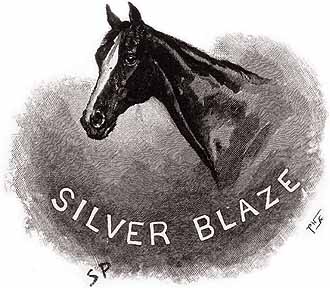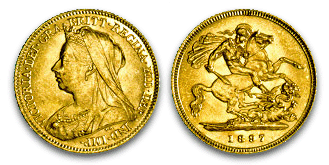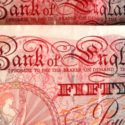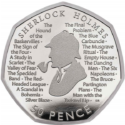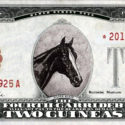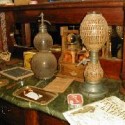A Scion Society of The Baker Street Irregulars
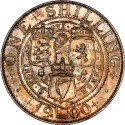
The Coinage of Sherlock Holmes (2013)
Sherlock Holmes was the fictional consulting detective of Victorian England invented by the author Sir Arthur Conan Doyle. Immensely popular in the days of his publication, Sherlock Holmes remains an icon of literature, detective procedure, and adventure, known to almost everyone today through the original stories and numerous modern adaptations in literature and on the screen.
Money and its surrogates—coinage and notes, stocks and bonds, wills, inheritances and dowries, and gems of all kinds—frequent the stories. Of course Sherlock Holmes solves crimes, and frequently the crime is theft. Or murder, fraud, counterfeiting, or blackmail with money as the motive. Money may be the actual driving feature of the plot, or it may be mentioned casually; dispensed to assistants, or offered as a reward to solve a crime, or paid as blackmail, or gambled away, or discussed as the earnings of a beggar or the salary for governesses and crime bosses— in short, money is woven densely into the fabric of Victorian life and into these wonderfully rich stories.
But what about the actual money? I have chosen two stories to highlight the money itself; what it was made of, what it looked like and where it was made, and how much it was worth, then and today.
Silver Blaze is the first story in the volume Memoirs of Sherlock Holmes. It was published in 1892. It is a lively story of betrayal and murder, horse chicanery, infidelity, and greed, all set in the world of upper crust English horse racing. Holmes is at his scintillating best, with Watson his stodgy but steady sidekick. Briefly, a famous racehorse named Silver Blaze, owned by Colonel Ross, disappears shortly before the big race. The trainer, John Straker, lies dead of a blow to the head on the moor near the stable. Holmes, through clever field work and deduction, realizes that the horse bolted free just as Straker was about to nick the horse’s tendon, which would render him slightly lame. In bolting, the horse himself inflicted the fatal injury on Straker, entirely in self-defense, it must be said. Silver Blaze had been found wandering free upon the moor by a neighboring horse trainer, who alters his appearance by dyeing the silver blaze on the horse’s face, and plans to keep him out of the race for his own personal gain of course. Holmes confronts the conniving neighbor, forces him to race the horse, but allows him to do so without changing the horse’s appearance back (this is a little payback by Holmes for Colonel Ross’ skeptical attitude toward Holmes). Colonel Ross wins the race, and is reunited with his horse.
The case is full of red herrings and obscure clues. We learn of the gentleman bookie who comes in the night and the gypsies on the moor. We puzzle at the surgical knife found in the dead man’s effects. There is a dish of curried mutton laced with opium served to the stable boy. There is the epidemic of lameness amongst the sheep, which Holmes deduces is the result of Straker practicing the tendon-nicking operation. Then there is a famous line uttered by Holmes in discussing the case with Detective Gregory, who asks:
“Is there any point to which you would wish to draw my attention?”
“To the curious incident of the dog in the night-time.”
“The dog did nothing in the night-time.”
“That was the curious incident,” remarked Sherlock Holmes.
Holmes cracks the case when he sees a bill in the dead man’s possession for a ladies’ walking dress for the sum of twenty-two guineas. Mrs. Straker, the bereaved widow of the dead trainer, denies any knowledge of the dress. Holmes realizes that the married Straker is leading a double life, has a mistress in town and was plunged over head and ears in debt trying to satisfy her expensive taste in haberdashery. Thus, his nefarious plot to sabotage his own horse.

What is a Guinea? The Guinea originated in 1663 as a gold coin bearing the portrait of the current ruler, worth a pound of sterling silver, or twenty shillings. The gold for its minting at least originally came from Guinea, in West Africa—hence the name. But over the years, the price of gold went up in relation to silver, and the relative value of the Guinea changed, achieving at its highest a value equivalent to thirty shillings. In the Great Re-coinage of 1816 the Guinea coin ceased to be minted in favor of the sovereign, and its value was officially assigned to be twenty-one shillings. Since that time it has remained as a sort of specialized shadow currency measure, not represented by any actual coin, but still actively used for various pricing practices such as professional fees, purchase of art, luxury items such as tailored clothing, and most particularly race horses. Auctioned racehorses are sold in Guineas, but the auctioneer pays off the seller in pounds. The difference is his commission. The Guinea has a distinctly quirky and aristocratic air to it, and seems quintessentially British. Oddly enough however, the Guinea has made it to Australia, and even to Egypt where the name of the Egyptian pound is “el geneh.”
John Straker, when he died, had five sovereigns in his pocket. Sovereigns and half sovereigns pop up from time to time in the Holmes stories (“The Church of St. Monica,” [cries Holmes on jumping into a cab] “and half a sovereign if you reach it in twenty minutes!” A Scandal in Bohemia). The Sovereign replaced the Guinea as the standard gold coin and unit of currency in 1816. It bore the portrait of the reigning monarch on the obverse and the current version has the dramatic Pistrucci engraving of St. George slaying the dragon on the reverse. It is made of 22 carat gold and contains 7.322381 grams or 0.235420 troy ounces of actual gold. This is close in gold content to our own half eagle, or $5 gold piece. Originally it circulated as a one pound coin, but in modern times has become a bullion coin. Sovereigns have been minted in Melbourne, Sydney, Perth, Bombay, Ottawa, and Pretoria in times past, and continue to be minted in London. A sovereign was a lot of money in Holmes’ day—a governess could get on quite well with a salary of 60 pounds a year, and Colonel Moran, the evil Moriarty’s right hand man, was paid the exorbitant amount of 6000 pounds per year (“paying for brains—the American Principle. Even more than the Prime Minister.” The Valley of Fear). Holmes did not comment on this rather large sum of money in Straker’s pocket (the equivalent of several hundreds of dollars in today’s currency) but he did joke to the Colonel that liberal as he was with his servants he doubted that Straker could afford his dashing mistress. Today a modern Sovereign trades near the bullion price of gold, and an uncirculated Sovereign from the date of publication of Silver Blaze is worth $225 in the Catalog of World Coins. Older Sovereigns carry a numismatic premium and are worth quite a lot more. Some people collect Sovereigns by date and mint mark.
Silver Blaze wins the race, but with short odds. “Hum!” said Holmes. “Somebody knows something, that is clear.” Holmes did not apparently bet on him. Holmes does bet on the next race however, saying that he stands to win a little, a shocking disclosure given his abhorrence of blind luck and emotionality. Arthur Conan Doyle teases us with this tidbit, but does not inform us whether Holmes’ horse wins or loses.
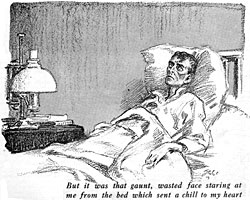 The Adventure of the Dying Detective was published in 1913; one of eight pieces in a compilation called His Last Bow. Here is the synopsis: Mrs. Hudson, the landlady, appears at Watson’s home and begs him to come see Holmes, saying that he is dying. Watson, horrified at the news, rushes to Baker Street. Holmes, it seems, has been investigating a case down in the docks. He has had the misfortune to contract a deadly Far Eastern disease, a coolie disease from Sumatra (called either Tapanuli Fever or Black Formosa Corruption, we are not sure), little known to western doctors. His appearance is appalling, and his mind wanders in and out of dementia. Holmes’ ramblings are exquisitely painful to Watson, who has recognized Holmes as the ultimate thinker and reasoner. “Of all ruins, that of a noble mind is the most deplorable,” thinks Watson. At one point Watson, aimlessly wandering around Holmes’ room, picks up a cunning little ivory box to inspect it more closely and Holmes shrieks for him to put it down. This bizarre little episode deepens Watson’s impression of the severity of Holmes’ illness.
The Adventure of the Dying Detective was published in 1913; one of eight pieces in a compilation called His Last Bow. Here is the synopsis: Mrs. Hudson, the landlady, appears at Watson’s home and begs him to come see Holmes, saying that he is dying. Watson, horrified at the news, rushes to Baker Street. Holmes, it seems, has been investigating a case down in the docks. He has had the misfortune to contract a deadly Far Eastern disease, a coolie disease from Sumatra (called either Tapanuli Fever or Black Formosa Corruption, we are not sure), little known to western doctors. His appearance is appalling, and his mind wanders in and out of dementia. Holmes’ ramblings are exquisitely painful to Watson, who has recognized Holmes as the ultimate thinker and reasoner. “Of all ruins, that of a noble mind is the most deplorable,” thinks Watson. At one point Watson, aimlessly wandering around Holmes’ room, picks up a cunning little ivory box to inspect it more closely and Holmes shrieks for him to put it down. This bizarre little episode deepens Watson’s impression of the severity of Holmes’ illness.
Watson, who is a doctor, of course wants to help but Holmes refuses to allow Watson to examine him. At first Holmes holds Watson off, warning him of the contagiousness of the disease. But Watson bravely protests that the danger of contagion would not be a consideration even with a stranger, and certainly not for his old friend. Then Holmes insults Watson by saying that which is painful for him to say, but nevertheless fact—that Watson is a general practitioner with limited experience and mediocre qualifications. Watson is bitterly hurt.
Holmes eventually sends Watson for help—not from a doctor but from a planter from the Far East who has studied the disease among his plantation workers. The planter, Culverton Smith, is initially reluctant but upon Watson’s entreaties eventually agrees to see Holmes. The interview is brief. Holmes’ condition has declined, and he appears near death. Realizing that Holmes will not live to testify against him, Smith admits to Holmes that he murdered a man for an inheritance by giving him the disease, and has also murdered Holmes by sending him the ivory box. The box is booby-trapped to eject a sharp spring when it is opened, which inoculates the unfortunate individual holding the box with the terrible disease. Smith sees the box on Holmes’ table and pockets it, the only shred of evidence against him, and then waits for Holmes to die. But Watson is hidden behind the bed and hears all. He can corroborate the confession; then on a clever prearranged signal (Holmes gaspingly asks Smith to turn up the gas as the shadow of death falls over his eyes!) the police come in and arrest Smith. Holmes describes to Watson how he realized the danger from the box, and faked all the symptoms of the disease by using make-up and not eating for three days in order to extract the confession. But he had to convince Watson of the gravity of his condition so that Watson would be a determined emissary to convince Smith. Holmes tells Watson that he refused to let Watson examine him because Watson, an astute physician, would have discovered that Holmes had neither a rise in temperature nor pulse and would have realized that Holmes wasn’t dying after all. Their friendship and trust restored, Holmes and Watson go off for dinner.
My favorite rambling of Holmes’ (remember that he is feigning confusion and dementia) is about half-crowns: “Now Watson,” said he. “Have you any change in your pocket?”
“Yes.”
“Any silver?” “
A good deal.”
“How many half-crowns?”
“I have five.”
“Ah, too few! Too few! How very unfortunate, Watson! However, such as they are you can put them in your watch pocket. And all the rest of your money in your left trouser pocket. Thank you. It will balance you so much better like that.”
This was raving insanity….
And one more favorite (and fake) rambling of Holmes’ disease-addled mind: “Indeed, I cannot think why the whole bed of the ocean is not one solid mass of oysters, so prolific the creatures seem.” And later: “No doubt there are natural enemies which limit the increase of the creatures. You and I, Watson, we have done our part. Shall the world then, be overrun by oysters? No, no; horrible!”
So leaving oysters aside, what about crowns and half crowns? Half crowns (worth two-and-a-half shillings or one eighth of a pound) were the largest circulating silver coin of the era. In 1913 the half crown was made of sterling silver, and contained 0.4204 troy ounces of silver. It was therefore slightly larger and heavier than our American silver half dollars. When Holmes defeated the evil planter Culverton Smith in 1913 lightly circulated coins from 1911 and later carried the portrait of George V facing left, but slightly older coins, from 1902 to 1910 carried the portrait of Edward VII facing right. And older coins than 1902 had Queen Victoria on them, facing left. By convention, every time the crown succeeded to another king (or queen), the portrait on coins faced in the opposite direction. The portraits of the male monarchs were stately but conventional. Victoria’s portrait since 1893 was the very matronly “Mature draped bust left,” but previous to that the young Victoria had some really gorgeous portraits.
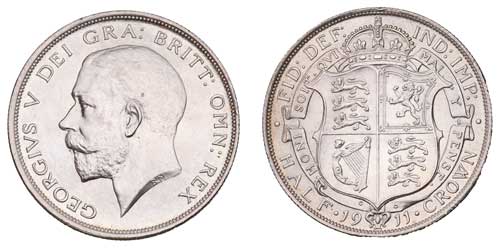
Mintages of half crowns were modest in the early years of the 20th century, mostly in the range of one to four million, with a couple of low mintages in the Edward VII series. Watson had five half crowns in his pocket. We can guess that a couple of them were nice Extra Fine or about uncirculated George V’s worth between $80 and $300 today. A couple of them were probably Very Fine to Extra Fine Edward VII’s. Maybe one coin was an older Fine or Very Fine Victoria half crown piece, most of which have modest catalog value in the present day. The most valuable half crown of the 20th century would be the 1905 issue in Uncirculated, with a mintage of 166,000, worth $10,500 today. Little did Watson know….
We can speculate what silver Watson might have carried in the other pocket to counter-balance the five half crowns. There were florins (two shillings) made of sterling silver and only slightly smaller and lighter than the half crowns. The florin from 1911 had one of the most attractive reverses in English coinage: the cross of crowned shields with scepters in the angles, by Bertram MacKennal. Florins and half crowns were minted right up to 1967, although they were debased to 0.5000 fine silver in 1920 and lost their silver altogether in 1947.

And then there were crowns. This was an imposing silver coin, weighing almost an ounce, and containing 0.8409 troy ounces of silver, more than a Morgan dollar. It was valued at five shillings or one quarter of a pound. The last crown minted for circulation was dated 1902, a one-year issue with Edward VII on it. The reverse was the famous frieze of St. George slaying the dragon, by Pistrucci. Only Proofs and commemoratives were minted after that. Eventually even the crown was debased, first to 0.5000 fineness and then to copper-nickel. Watson might have had a crown in his pocket. For the sake of the balancing exercise, it was exactly the weight of two half crowns.
Small British coins were still sterling silver in 1913, including the shilling, the six pence, and even the three pence. The four pence and two pence were issued in silver in that era but as proofs only. So I agree with Holmes that five half crowns were likely not enough to achieve good balance.
And what about the planter from Sumatra, the evil Smith, who murdered by disease? Sir Arthur Conan Doyle does not inform us what was in his pockets. But he may have been carrying coins from that most mysterious coin-issuing entity, the Straits Settlements, whose coinage remained legal tender in the British and Dutch held Straits of Malacca area (the important waterway between Sumatra and Malaya) well after Sherlock Holmes’ era, until 1952.
Reprinted from pages 5-8 of the March – April 2013 issue of RNA News, official publication of the Rochester (NY) Numismatic Association.
Copyright of this post remains with the author and the RNA.

